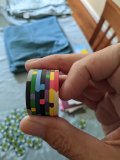jvspin
Sitting Out
Okay, been doing some experimentation using the procedure above. Chips dropped one at a time, often hitting the previously dropped chip edge first. Here are some results. Note, all chips unused before testing. Rotated chips to show damaged areas for photo.Drop 10 chips (marked) into a pot of 40 chips (un-marked/pot chips) - atleast 100 times from 12 inches, weight the flea bites on the table too after since thats also part of the science
EDIT: As much as you can sweep up*
Chips tested so far.
Blue Spirit 4D14
Purple Spirit 4D14
Green Great Wall 4D14
Paulson sample set
Notes: One chip broke along join of white to blue. Damage mostly in white. Just as hard to break the blue chip in one hand as the purple.
Paulson before
Paulson after
Also of note:
1) other than the pieces of the broken blue chip, there weren't enough flea bites to register on my 0.00g scale.
2) the chips in the pot don't show anywhere near as much damage as the chips being tested so moving forward I'll use the same purple chips as the 'pot'.
Last edited:

